Ineos Grenadier Quartermaster First Drive Review: Dripping in character, damned by chickens

JOSHUA TREE, Calif. – Subjectively, the 2025 Ineos Grenadier Quartermaster is a deeply lovable truck. It is dripping in character, from the bank of cockpit-style switches on the dash and ceiling console to the name itself. You know you’ve got something interesting when answering “What car is that?” stretches to 10 syllables. For those longing for an even simpler, more analog off-roader than the Wranglers, Land Cruisers and G Wagens of this world provide, it proudly flies its old-school flag packing front and rear live axles, recirculating ball steering, high and low range selected with a sturdy shifter, and multiple locking diffs. If you see some sand ahead and feel the need to turn a dial to an icon with a little cactus on it to get you through, the Quartermaster isn’t your truck.
Objectively, however, the Quartermaster probably won’t be your truck for a whole lot of other reasons. Price is the big one. It starts at $86,900, or $15,400 more than the Grenadier SUV or “Station Wagon” as Ineos calls it, inevitably to the confusion of every American. You can read more about that version in our Grenadier first drive review. The reason for the Quartermaster premium has little to do with the frame and wheelbase that’s a foot longer, nor the 61.5-inch-long bed that stretching accommodates. No, the blame goes to West Germany, Lyndon B. Johnson and chickens.
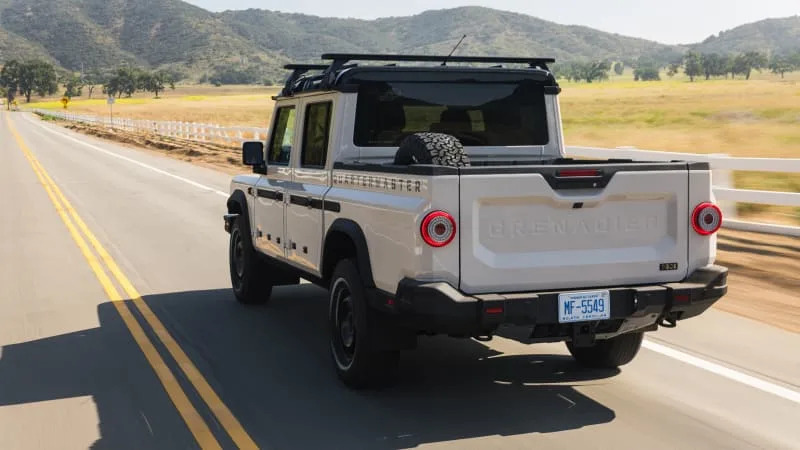
Back in the early 1960s, the Johnson administration responded to French and West German tariffs placed on a variety of American products, most notably chickens, with a 25% import tax. The United Auto Workers, meanwhile, wanted to curtail the importation of West German-made Volkswagen commercial vans and pickups, and effectively negotiated with the Johnson administration to apply the chicken tax to such commercial vehicles in exchange for not striking. The auto industry would continue to lobby for its application long after chicken tax tariffs were lifted on other products, thereby making it much harder for Japanese companies, particularly in the 1980s, to import its small trucks.
Companies have circumvented the tax in various ways over the years, but Ineos doesn’t feel the need to do so for the Quartermaster, which is built in Hambach, France, in an old Smart factory. The result is a pickup that’s not only far more expensive than its nearly identical SUV sibling, but one that can easily stretch past $100,000 with a reasonable selection of options. It doesn’t feel like it should. Admittedly, there’s no other pickup of its size and power source (gasoline versus electric) in that price range, nor does another off-roader of that price tag offer a pickup bed. Still, it’s a tough pill to swallow.
At least here in the United States. In Australia, the Quartermaster should have no problem finding homes. Its relatively narrow width and short bed, not-palatial crew cab and old-school off-road capability perfectly match the modern definition of the Aussie “Ute.” Indeed, Ineos anticipates 80% of Grenadiers sold Down Under will be either Quartermasters or the chassis cab variant we won’t get.

The American venue chosen to showcase the Quartermaster could certainly be mistaken for Australia, albeit with beige dirt instead of red, and Joshua trees in lieu of eucalyptus. We’re tackling dusty, rocky trails just outside Joshua Tree National Park, often at a decent clip that has the sturdy Grenadier proving resilient to the vicious vibrations caused by washboard surfaces and the solid thwacks of big heaves.
The recirculating ball steering rack is the Grenadier’s most controversial element, a fact telegraphed by how often the folks at Ineos seem to bring it up. There have been potential customers who said “no thanks” after giving it a try, no doubt finding the dead on-center feel, lack of self-centering and stiff turn-in disconcerting and totally different than modern rack-and-pinion systems, typically with electric power assistance. Younger drivers in particular, who may never have driven a car without EPS let alone a recirculating ball setup, should find it particularly foreign. They also may find it novel, just one of many throwback, analog sensations expected for not only the Grenadier but off-roaders in general.
I personally didn’t find it that big of deal, and it’s certainly not as agricultural as I was expecting. The biggest issue is on-center corrections at highway speeds, as well as sudden turns. There was a point while driving at a higher speed in convoy with other Quartermasters that the dust ahead cleared to reveal a sudden right-turn and a metal fence beyond. Quick decision! I yanked the wheel to the right to be met by a wall of resistance that wouldn’t be there with other steering systems. I muscled the two-spoke wheel even further and harder, while hitting the long-travel brake pedal. Fence avoided, worst case experienced.
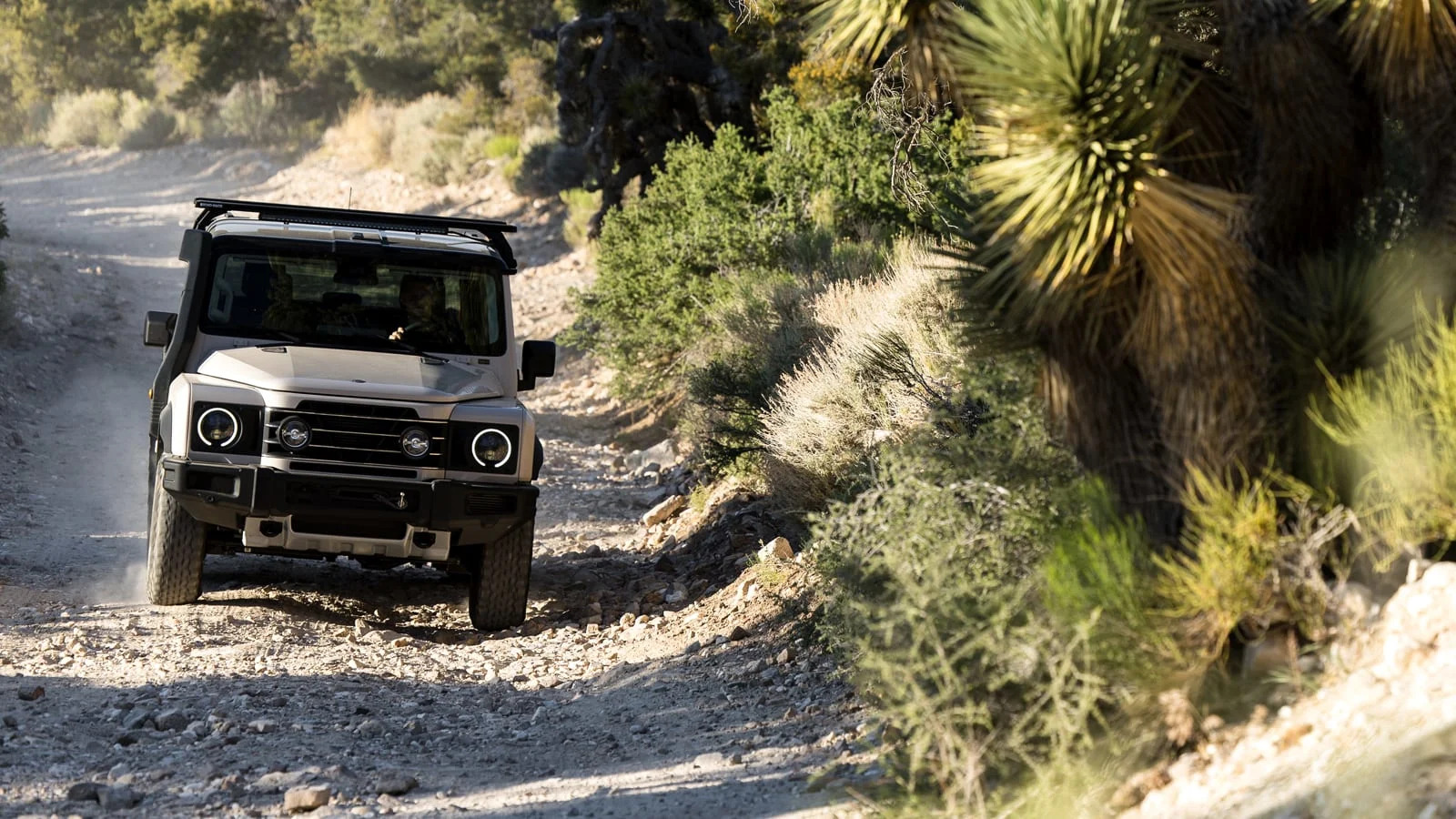
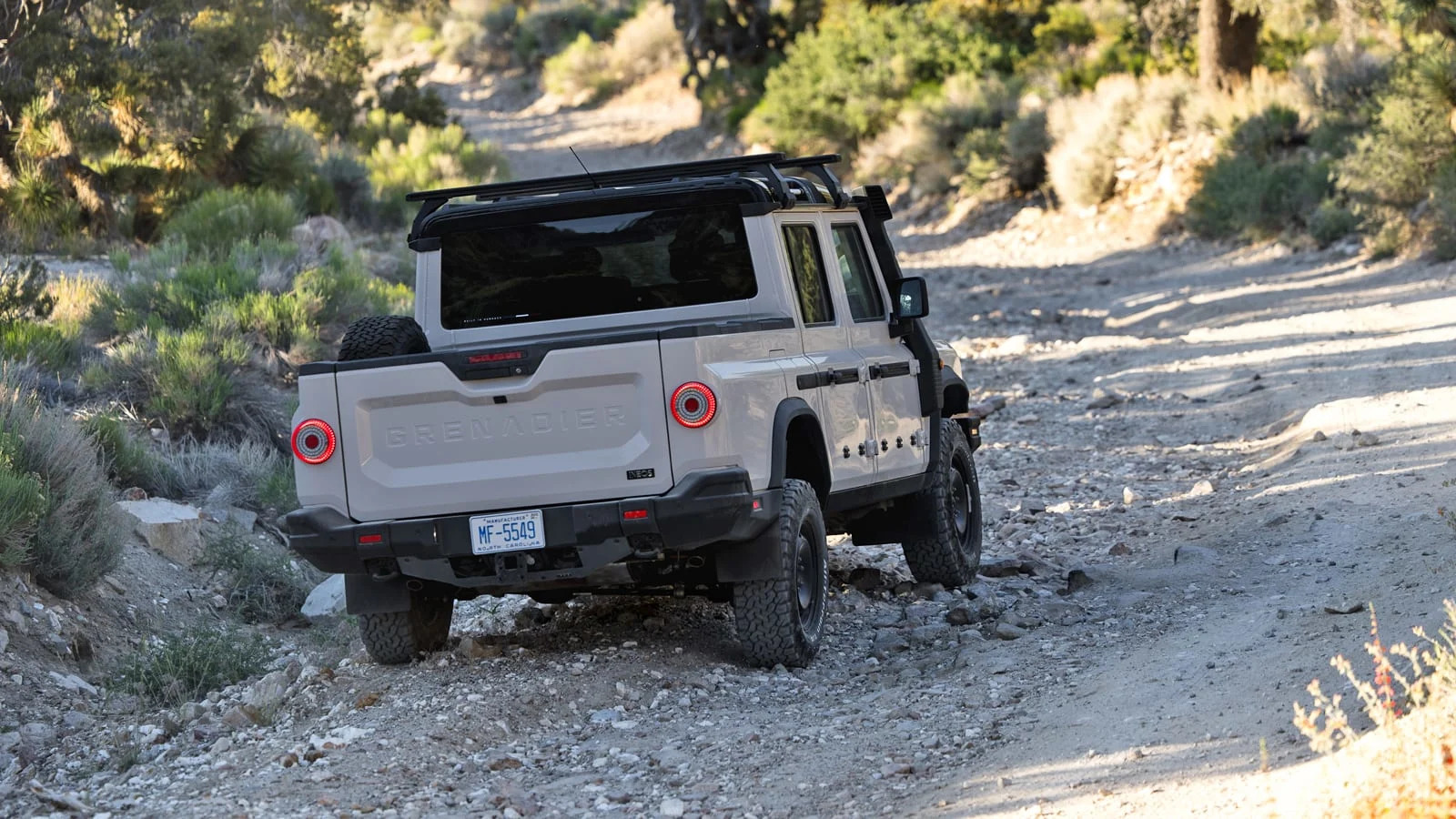
So why bother with ye olde steering? Well, we also did some mountain goating. I’ve long been trained to not wrap my thumbs around the steering wheel spoke while off-roading, as sudden kickback can, well, break them. That’s a rack-and-pinion thing. It’s far less likely to happen with recirculating ball, and indeed, our rock-crawling stints were easy-cheese from a steering perspective.
The throttle could be difficult to modulate in such situations, however. There’s not much reaction with initial throttle tip-in and the delay in response created some anxiety that I’d over-gun it and launch the Quartermaster into a boulder. I didn’t, but finer pedal feel or a change in throttle application would be appreciated.
Perhaps this is related to the Quartermaster sharing its powertrain with cars that are almost the opposite of a body-on-frame, live axle pickup truck. The 3.0-liter turbocharged inline-six is by BMW (it even says so on the hood) and the eight-speed transmission by ZF, both of which go together in umpteen BMWs. Output stands at 281 horsepower and 331 pound-feet of torque, and although the 0-60 time is estimated to be a slow-by-modern-standards 8.8 seconds, it certainly doesn’t feel as slow as I was expecting. Out on the open road, it gets up to speed smartly with ample low-end torque. The smoothness and sound you’d expect from the Bavarian Motor Works is certainly present, too. That said, the ZF transmission is too quick to upshift while driving at speed uphill. In anattempt to compensate, I instinctively slapped the BMW-sourced transmission lever over to the left to select the Sport mode promised by the M/S marking, but discovered there is no S. Only M.
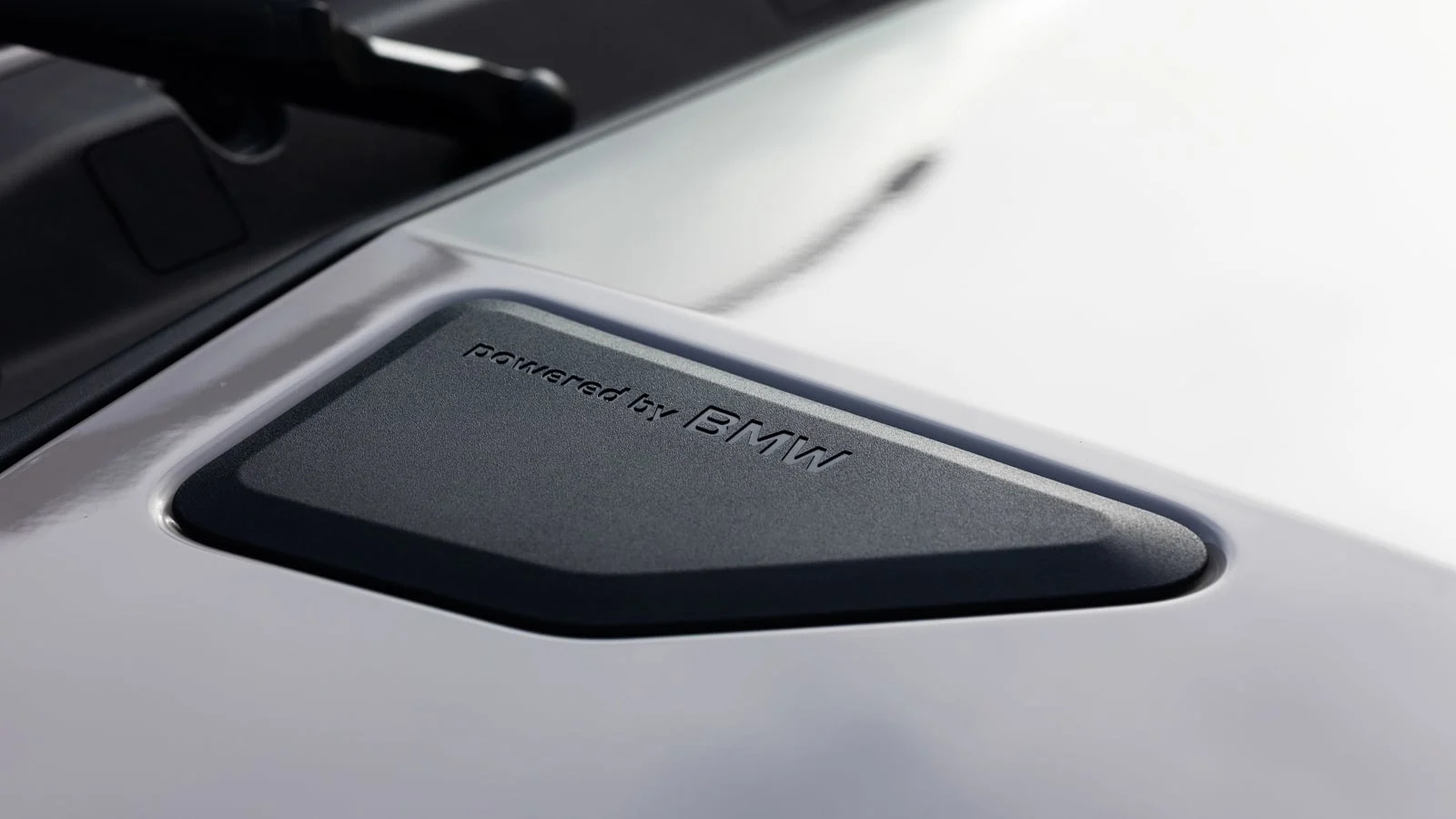

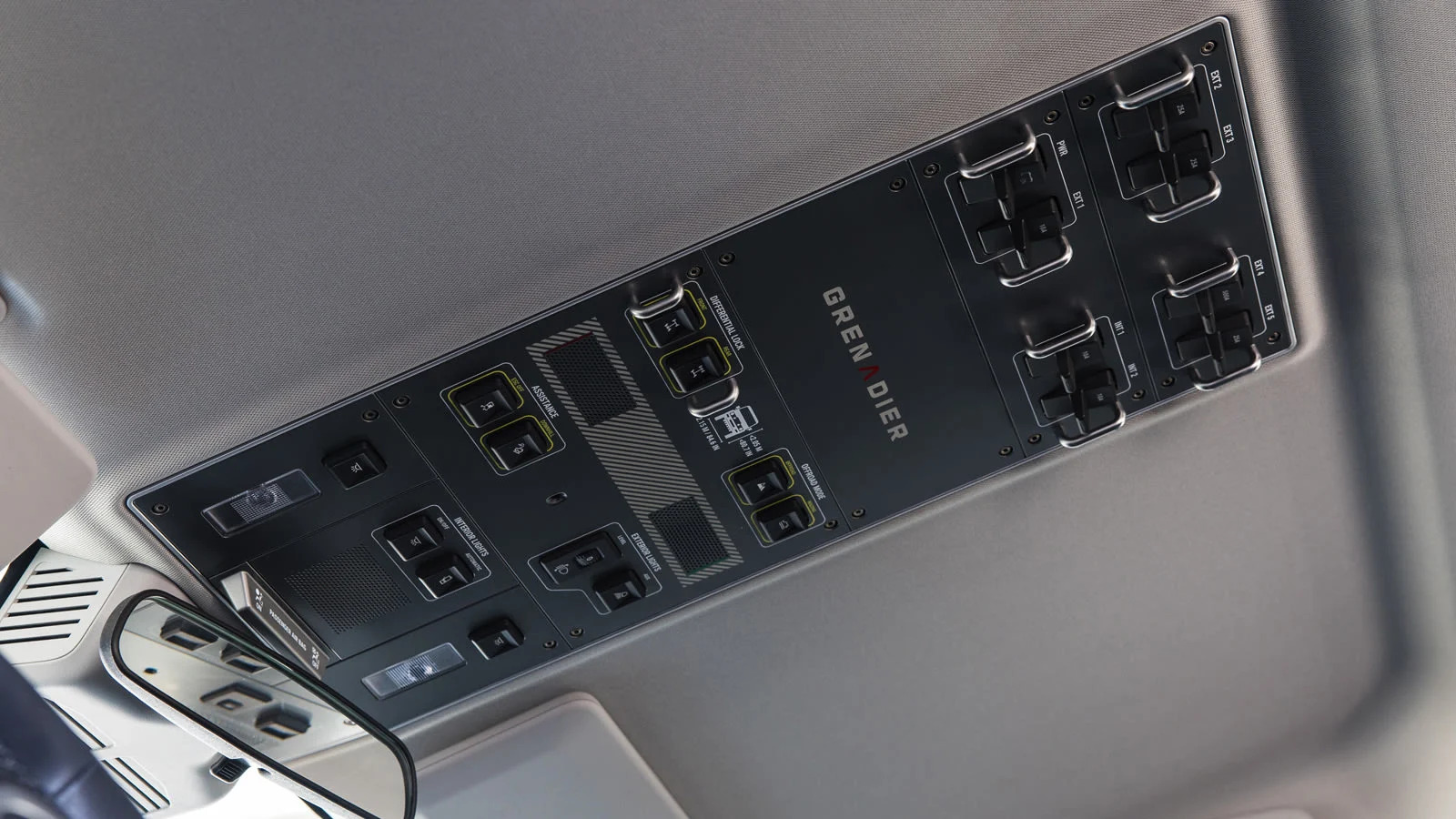
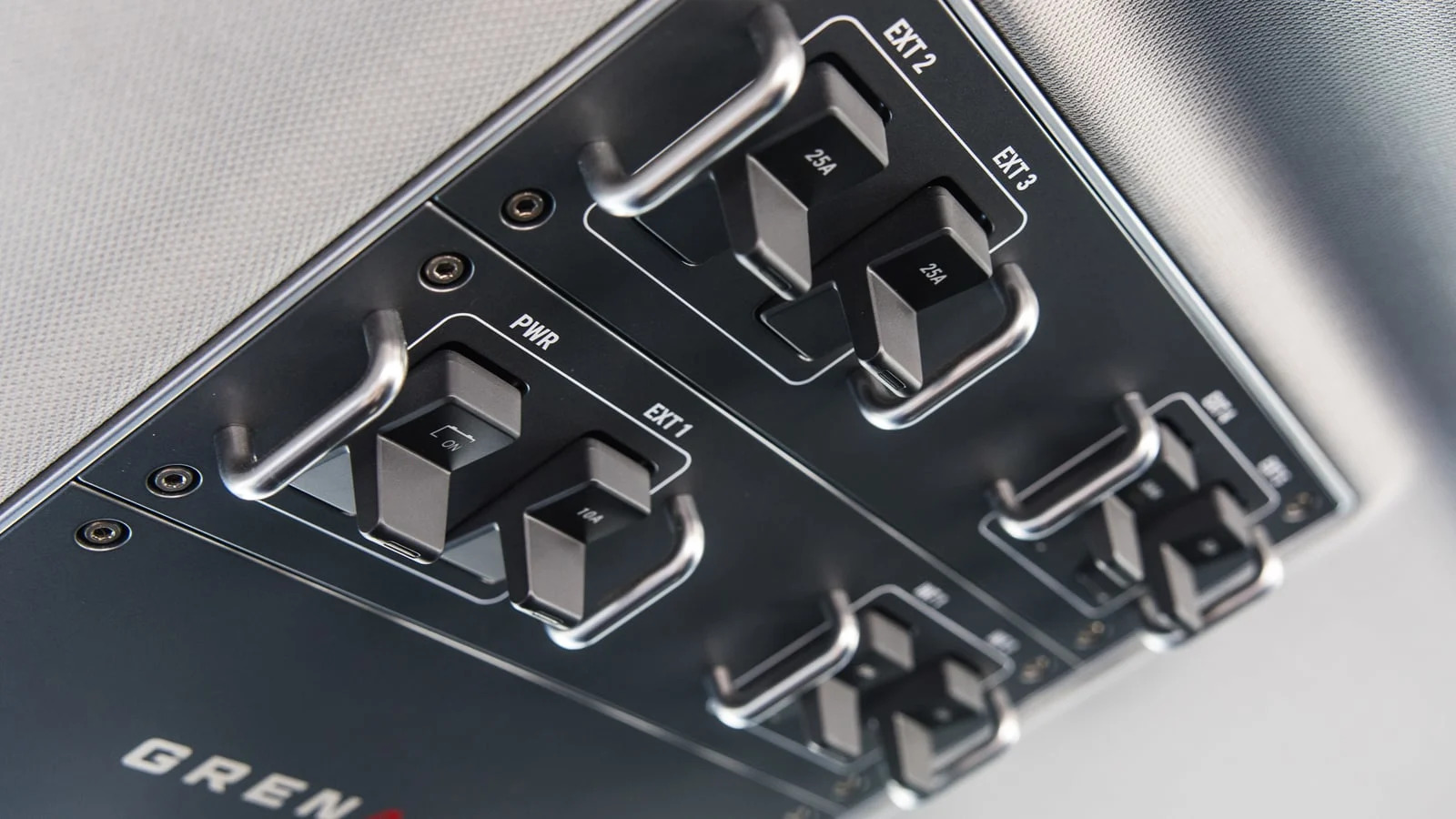
Better than nothing, I suppose, but it’s a curious bit of half-assed parts bin pilfering for a cabin that is otherwise shockingly bespoke. All the other buttons, toggles, stalks, etc. are Ineos pieces. The toggles in particular are super-cool, as it’s hard not to turn the car on (via a switchblade-style key, BTW) and immediately flick two or three unconnected auxiliary toggles in the ceiling just to feel like an astronaut. I may not be Buzz Aldrin, but I play one on the way to Lowe’s.
Speaking of such journeys, the Quartermaster bed has a payload capacity of 1,889 pounds, which is about 500 more than a Jeep Gladiator Rubicon, which is quite obviously the closest thing in concept to the Quartermaster (although the Jeep has a different frame than its own SUV sibling). The 61.5-inch-long bed is an inch longer than a Gladiator’s, as well as 6.9 inches wider at its greatest point (63.7 inches). Of course, a Gladiator does not have its spare tire taking up space in the bed, which the Ineos does. It’s cleverly sunk into an indentation on either side of the bed (you could stuff two spares back there if you’d like), but it takes up space nevertheless. The tailgate is also not damped, a common truck feature nowadays, meaning it just uncouthly slams down.
As with the regular Grenadier, there are grab handles/tie-down points above the rear doors, unique movable tie-down points on the doors, and available “safari” windows over the front seats. There are numerous customization options, including a unique contrast-painted ladder frame (there was a Quartermaster painted Britannia Blue with a Halo Red frame and Scottish White roof that was particularly cool) and numerous accessories such as an integrated front winch and removable rear winch. Should make for a fun tug of war.
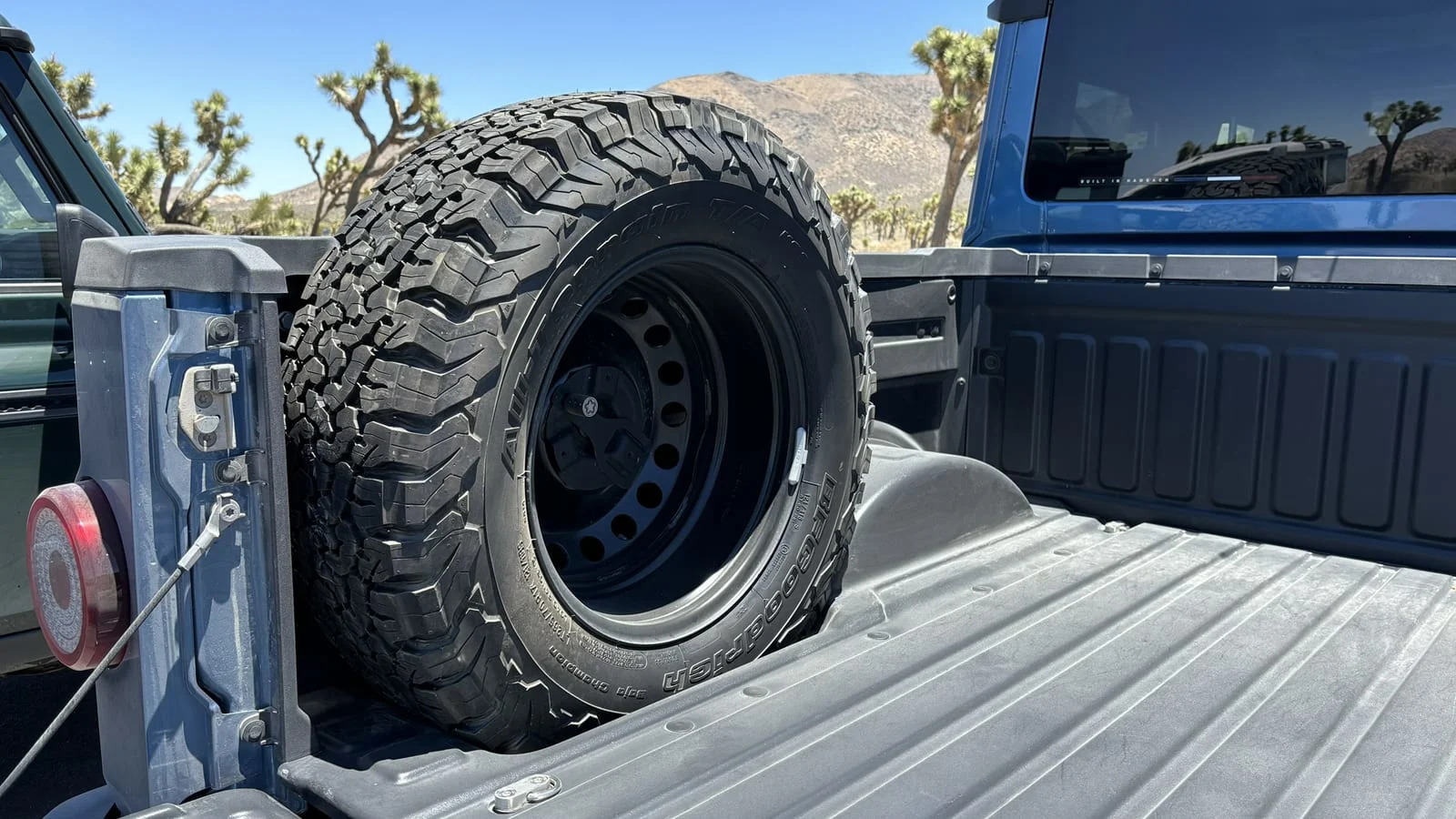

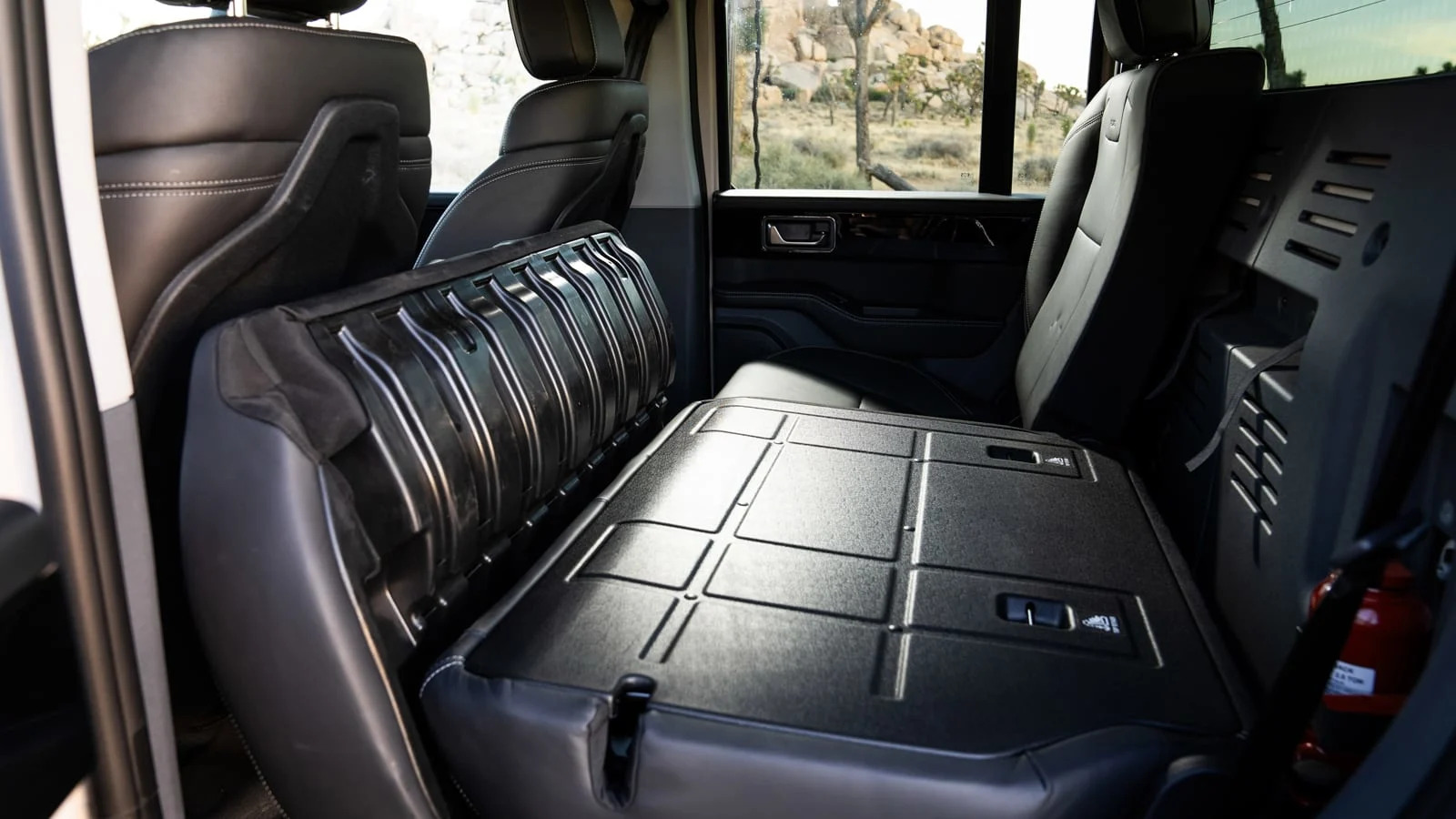
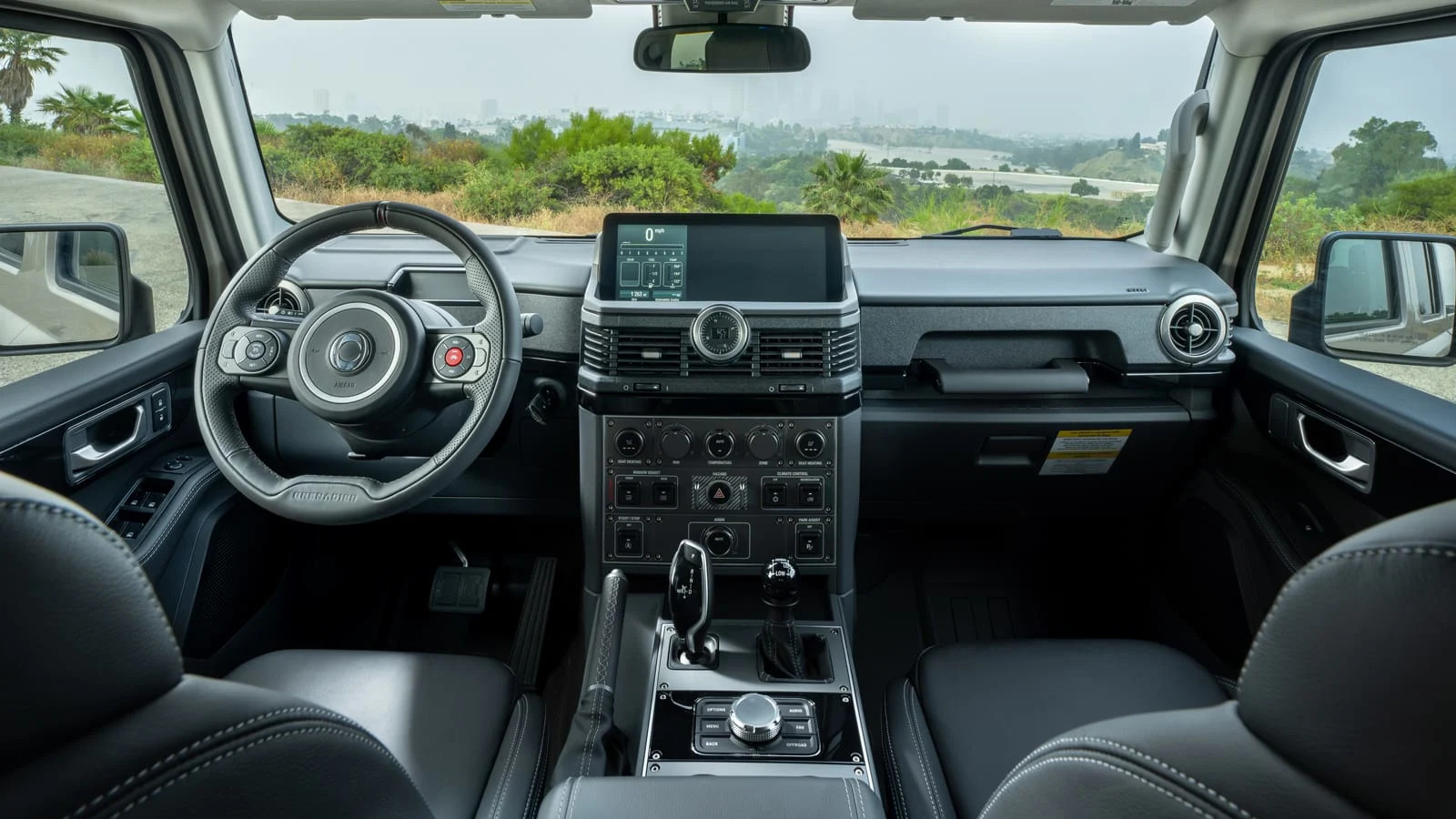
The cabin forward of the front seats is common between SUV and Quartermaster, though the truck’s rear seat back is notably more upright and it sure seems like passengers will tire quickly of riding along bolt upright. Legroom is iffy, too, especially if those up front take full advantage of the admittedly appreciated vast seat travel. If they do, hope you like sitting cross-legged. Furthermore, utilizing the fold-flat rear seatback for storage requires you to first flip forward the rear seat bottom which in turn pushes the driver seat far forward. Either way, not ideal.
Other niggles include double-sealed doors that pretty much never close on the first go unless you get in the habit of slamming them. Once inside, there are Tesla-style instruments baked into the center touchscreen, with a panel in front of the driver exclusively devoted to the turn signals and various warning lights that go bonkers when you engage Off-Road mode. The touchscreen itself, which is a unique user interface that comes equipped with wireless Apple CarPlay and Android Auto, also washed out throughout the day in the intense desert sun. While its placement makes sense for a British company trying to minimize costs by not creating two different angled center stack designs for left- and right-hand drive markets, there is definitely a downside.
Ultimately, given the Quartermaster’s lofty chicken tax price tag, compromised back seat and the Gladiator’s lackluster sales compared to the Wrangler, it seems likely that the Grenadier “Station Wagon” will find a lot more takers. It has just as much charm (and better rear-end looks I might add), along with the inherent benefits and drawbacks of Ineos’ purposeful, throwback concept. Then again, if you’ve got the money, have extra room in the garage, and are already well accustomed to paying more tax than you think you should, why the heck not? The guy with the Bronco Badlands down the street will be so jealous.






